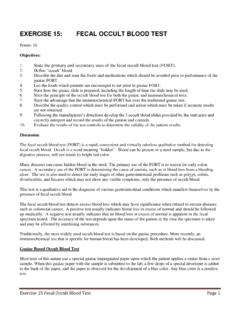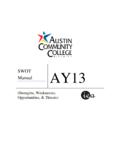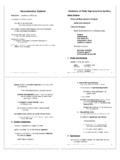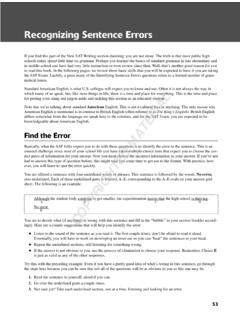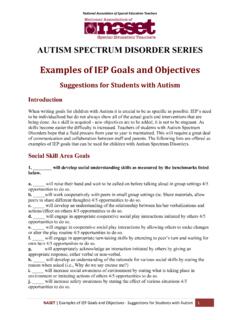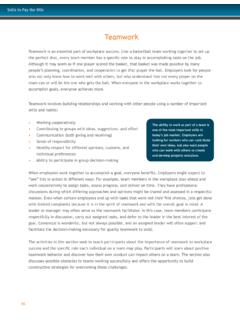Transcription of SWOT Training Manual(Strengths, Weaknesses, Opportunities ...
1 SWOT Manual AY13 (Strengths, Weaknesses, Opportunities , & Threats) Page | 2 Austin Community College SWOT Team manual Contents What is a SWOT? .. 3 Benefits of a SWOT Analysis .. 3 SWOT Materials .. 4 How is the SWOT conducted? .. 5 Proposed List of areas should be covered: .. 6 What s NEXT? .. 7 ACC SWOT Procedures/ Processes and Scheduling .. 8 SWOT MANUAL (download pdf) Page | 3 Austin Community College SWOT Team manual What is a SWOT? A SWOT analysis is a planning tool that, when used properly, provides an overall view of the most important factors influencing the future of the program. The SWOT analysis is the foundation for a reflective self-assessment of how your unit is performing its mission.
2 The SWOT analysis results form the basis for developing recommendations and action plans, also known as Quality Improvement Plans (QIPs). These recommendations and action plans take into consideration many different internal and external factors that maximize the potential of the program s strengths and Opportunities , while minimizing the impact of its weaknesses and threats. This approach can help ensure efficient use of resources to provide beneficial program outcomes. A SWOT analysis enables proactive thinking rather than habitual or instinctive reactions A SWOT analysis is one of several tools for assessment and planning at Austin Community College. This manual is meant to help understand the general SWOT analysis process, as well as provide detailed guidance for a organizing and conducting a SWOT analysis. Units are required to conduct an intensive self -review on a 5-year rotating schedule.
3 The Instructional Program Review (IPR) and the Support Services Review (SSR) both follow the same general process. During an intensive review year, units participate in a facilitated SWOT analysis to determine what their strengths and weaknesses are and how the environment will affect their ability to accomplish their mission Benefits of a SWOT Analysis A SWOT analysis is a simple, but powerful, framework for leveraging the unit s strengths, improving weaknesses, minimizing threats, and taking the greatest possible advantage of Opportunities . SWOT analyses have several benefits Opportunity for collaboration on strategic plan formulation. Incorporates many different internal and external factors. Structured process that allows for a thorough idea gathering. The posting of the ideas vs. the yelling minimizes the reactionary processing and group mentality from occurring.
4 Participants who may traditionally be quiet and participate less, are encouraged, and have the ability to participate in a process which is friendlier to their needs. Allows the ability for dominators (overly vocal participants) of the process to be equalized -- but not eliminated. Responses are prioritized within each category, by importance, giving units a clearer understanding of their most pertinent topics and areas to address. Page | 4 Austin Community College SWOT Team manual How are the Results of a SWOT Analysis Used? A SWOT analysis is a subjective assessment of data that is organized into a four- dimensional SWOT matrix, similar to a basic two-heading list of pros and cons. Strengths what the unit does very well internally Weaknesses where functions are performed internally less than preferred Opportunities potentially favorable external conditions for the unit S&O: Pursue Opportunities that are a good fit with the program s strengths.
5 W-O: Overcome weaknesses to pursue Opportunities Threats potentially unfavorable external conditions for the unit S-T: Identify ways the program can use its strengths to reduce its vulnerability to external threats. W-T: Establish a defensive plan to prevent the program s weaknesses from making it highly susceptible to external threats. To develop initiatives (strategies) that take into account the SWOT profile, unit members can translate the four lists into a matrix (see above) that associates strengths (maintain, build and leverage), Opportunities (prioritize and optimize), weaknesses (remedy), and threats (counter) into actions that can be agreed and owned by the unit. SWOT Materials The facilitator is responsible for providing the following materials for the SWOT session. If you are going to conduct (facilitate) a SWOT session yourself, you will be responsible for providing these materials.
6 Post-Its LARGE (multi-colored, minimum of 4 colors, super-sticky note ) Alternative style sticky note for labeling groups Name tags (optional) Black markers (no fine point, need to read at distance) Paperclips or binding clips Masking tape Multi-colored sticker dots (med size) Page | 5 Austin Community College SWOT Team manual How is the SWOT conducted? Identification of Strengths, Weaknesses, Opportunities and Threats. (SWOT) The facilitator should introduce the group and set some ground rules/ guidelines. The facilitator should lead a discussion about the unit/program s data and how they relate to the unit/program s performance of its mission. This will help illuminate existing strengths and weaknesses. The strengths and weaknesses should help identify possible Opportunities and threats.
7 After the discussion of the data, the facilitator will walk the participants through the process of brainstorming about each of the SWOT elements, one at a time ( Strengths first, then Weaknesses, then Opportunities , then Threats). Participants will be asked to relate their thoughts or comments to the data and write them down on the Post Its. NOTE: While conducting the session, encourage participants to use phrases that are clearly understood when writing out suggestions or comments for posting. Clarify SWOT statements during the session to ensure context of statement in future discussions and analyses. o Strengths in what ways does the unit/program excel? o Weaknesses what aspects of the unit/program, which, if not addressed, will impede the area's future? o Opportunities what factors, which the unit/program needs to take advantage of that, might enhance the quality of the area.
8 O Threats what external factors could negatively affect the unit/program s future? SWOT Process: o The facilitator should circle the room continuously collecting the post-its. o The notes should be placed in a random pattern across the front of the group minimizing and ensuring that they are not clumped with or by any bias. o When the group seems to have finished with writing topics, the facilitator should then proceed to read aloud the entire list on the wall. o Next, the SWOT participants are encouraged to come up and group the topics into themes or likenesses. o The facilitator will next work with the participants to collectively come to an agreement and agree on a title for each of o There may be a massaging of the groupings upon the themes that are brought out. Page | 6 Austin Community College SWOT Team manual o After the groups are titled, the facilitator re-reads the clusters to ensure that the consensus is that all topics fit under that them.
9 O Next, the facilitator hands out to the participants an apportioned set of sticker dots. o The participants use the dots for ranking. o The participants can use them to rank either the group themes or individual topics within the cluster. o The facilitator then collects and stacks the clusters, ensuring to stack so that report writing can be one easily. o Upon completion of the STRENGTHS portion, the facilitator may encourage a brief break or move onto the next section. NOTE: Once all statements have been reviewed on the board, for the purpose of more efficient and accurate processing/ reporting, the facilitator is asked to stack the Post-its according to the identified categories. This will allow the person creating the SWOT report to quickly (and more reliably) input the data. NOTE: There may be a need for the facilitator to keep the focus of the group on task. The group may start to wander off topic and into another area of the SWOT process.
10 Proposed List of areas should be covered: 1. NEED Is the need for the program/unit increasing, decreasing, staying the same? 2. COST a. Are program/unit costs increasing, decreasing, staying the same? b. In what areas is our budget adequate/inadequate? 3. PROGRAM/UNIT EFFECTIVENESS Questions for program/unit effectiveness will vary, depending up the area or program/unit being addressed. Although this list is not comprehensive, some examples are listed below: Some of the following areas will be specifically applicable to instructional programs and some to administrative units. Some areas will be applicable to both. Choose areas that are relevant and/or correlate to your program/unit s data. Student Achievement Are graduation/transfer rates a concern? Student Retention Are course completion rates higher/lower than average? Student Outcomes How do students do at transfer institutions?


